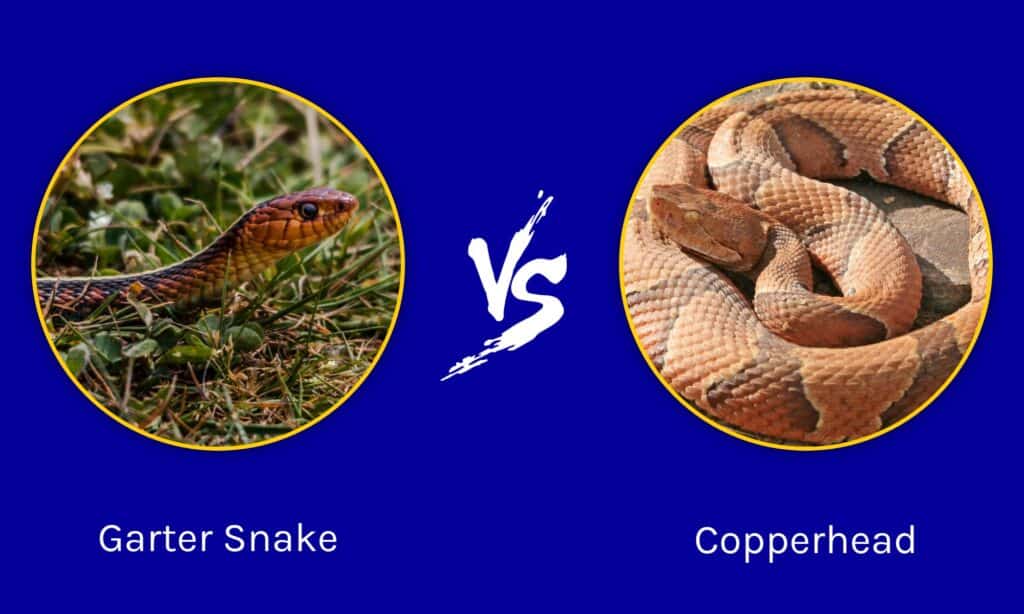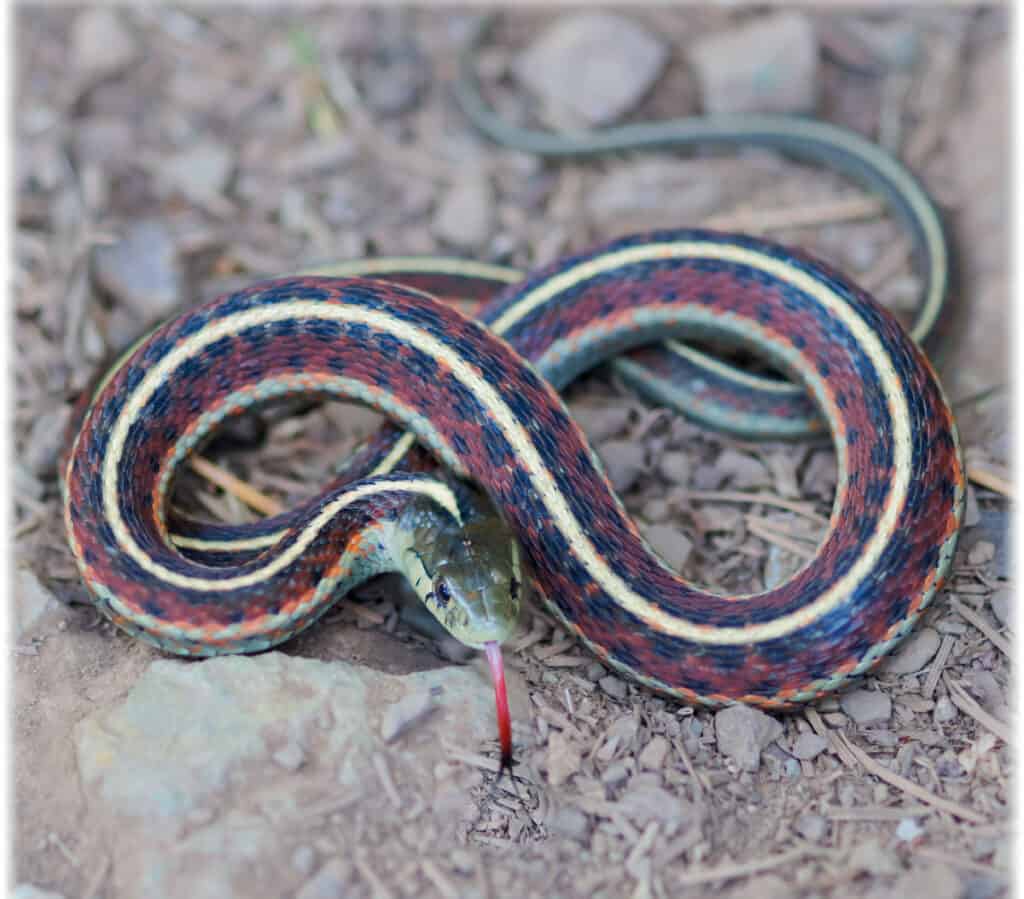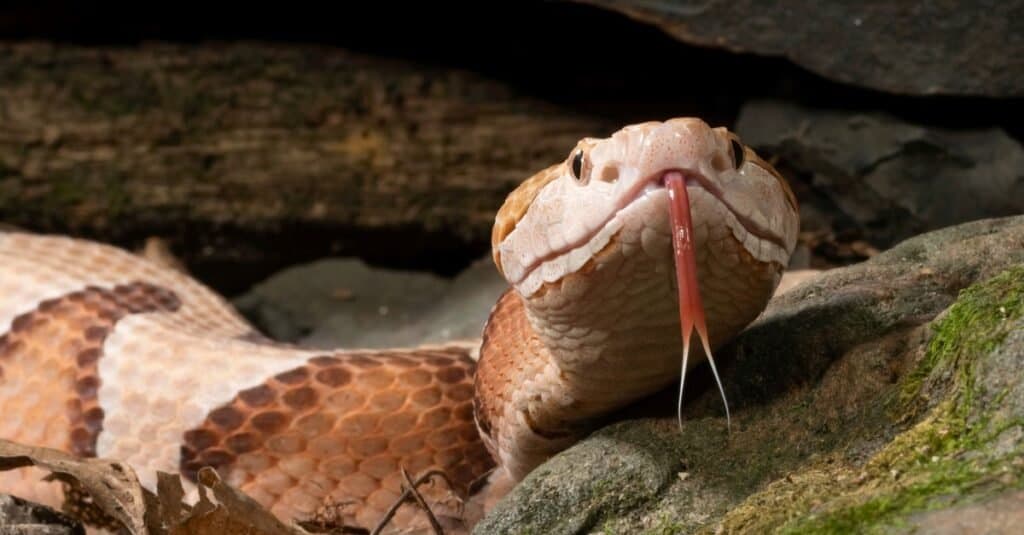Garter Snake vs Copperhead: How are they different?
#mobileSnakeQuizControls { overflow: hidden; text-overflow: ellipsis; white-space: nowrap; }
@media (min-width: 481px) {
.mobile-top-content {
display: none;
}
}
#mobileTopContentCTACarouselControls { overflow: hidden; text-overflow: ellipsis; white-space: nowrap; }
.mobile-top-content .more { color: #fff; }
.mobile-top-content a { color: #fff; text-decoration: underline; }
.mobile-top-content a:hover { color: #fff; text-decoration: underline; }
@media (max-width: 480px) {
.mobile-top-content {
background-color: #06a10b;
color: #fff;
text-align: center;
/*height: 60px;
padding-top:5px;*/
font-size:80%;
/* display: block; */
margin: 0px -30px;
}
}
Garter snakes are named for their resemblance to the garter belt, a narrow band of fabric used to hold up stockings on the leg. Copperheads get their common name from their heads resemblance to a copper penny. One of these snakes is a common garden companion, keeps pests at bay, and stays mostly out of sight. The other also prefers not to be seen but is responsible for more snake bites yearly in North America than any other type of snake. Let’s look at garter snake vs. Copperhead and seek insight into their separate serpentine natures.
Key Differences between the Garter Snake and Copperhead

A-Z-Animals.com
The key differences between garter snakes and copperheads are their scientific families, slightly different ranges, size, eyes, markings, hunting methods, and venom potency.
button.pulse {
transform: scale(1); animation: pulse 2s infinite;
box-shadow: 0 0 0 0 rgba(11, 247, 25, 1);
}
@keyframes pulse {
0% { transform: scale(0.90); box-shadow: 0 0 0 0 rgba(11, 247, 25, 0.5); }
60% { transform: scale(1); box-shadow: 0 0 0 15px rgba(11, 247, 25, 0); }
100% { transform: scale(0.90); box-shadow: 0 0 0 0 rgba(11, 247, 25, 0); }
}
Garter Snake Vs Copperhead: Comparison
| Garter Snake | Copperhead | |
| Scientific Classification | Family: Colubridae; Species: Thamnophis sirtalis (Common garter snake) | Family: Viperidae; Species: Agkistrodon contortrix |
| Range | Throughout North America, varies by species | Central and Eastern United States varies by subspecies |
| Size | 18-42 in. long | 22-36 in. long |
| Appearance | Various colors including black, brown, and green, stripes along body, round pupils | Rich copper and brown hues, hourglass-like cross bands along the body, vertical slit pupils |
| Hunting | Hunt by peering, craning, ambushing. Rely on scent and vision | Primarily hunt by ambushing, Rely on scent, vision, and heat through pit organ |
| Venom | Only mildly venomous, mild pain, bruising, and swelling after a bite | Venomous, bites cause pain, edema, hemorrhage, fever, and lethargy but very rarely lead to death in humans |
Garter Snake vs Copperhead:Scientific Classification
The garter snake also called a grass snake, is part of the family Colubridae. Its genus Thamnophis includes about 35 species of snakes. The name is derived from the Greek words thamnos, meaning “bush,” and ophio, which means “snake.” The species name for the common garter snake is Thamnophis sirtalis. Sirtalis is Latin for “like a garter” and likely refers to the dorsal stripe that these snakes display. The common garter snake is further divided into 13 recognized subspecies, including the eastern garter snake (T. s. sirtalis), the red-spotted garter snake (T. s. concinnus), and the maritime garter snake (T. s. pallidulus).
The copperhead snake, also known as the eastern Copperhead, is a pit viper of the family Viperidae. Its species name is Agkistrodon contortrix. The genus Agkistrodon is shared with cottonmouths and American moccasins. The word comes from the Greek ancistro, which means “hooked,” and odon, meaning “tooth.” Contortrix comes from the Latin contortus, meaning “twisted, complex or intricate,” in reference to the hourglass patches on these snake’s backs. So, the species name can be interpreted as a “hooked-tooth snake with twisted bands down its back.” The subspecies include the Southern Copperhead (Agkistrodon contortrix contortrix), Northern Copperhead (Agkistrodon contortrix mokasen), Osage Copperhead (Agkistrodon contortrix phaeogaster), and the Trans-pecos Copperhead (Agkistrodon contortrix pictigaster).
Garter Snake vs Copperhead: Habitat and Range

iStock.com/yhelfman
Native to North America, garter snakes enjoy a range from Costa Rica to the subarctic plains of Canada. The specific boundaries vary for each species. You can find garter snakes in gardens, lawns, woodlands, fields, and forests. They also live in wetlands, marshes, meadows, and ponds. Garter snakes prefer temperate, densely forested wetland areas and are most often found near water. Although they’re primarily terrestrial, they are powerful swimmers.
Copperheads are found throughout the central and eastern United States. They range from southern New England to eastern Kansas and Nebraska, then south to Texas and Florida. They’re also found in localized areas of Mexico. They live in areas with downed woody vegetation and low, wet woodlands, the edges of swamps, and riparian zones. They associate with man-made areas of construction sites, sawdust piles, and suburban areas.
Garter Snake vs Copperhead: Appearance

Jeff W. Jarrett/Shutterstock.com
Garter snakes are typically thin snakes with a length of between 18-42 inches. They normally have narrow heads but can flatten them to mimic more venomous snakes. Their eyes have round pupils. Their coloring varies by species, but typically the base color of their bodies is black, brown, or green. Most have three stripes running the length of their bodies. These tend to be yellow in common garter snakes, but maybe white, green, orange, red, or blue. While the majority exhibit stripes, some have bodies that are solid in color, and others have splotchy patterns between their stripes, making them appear checkered.
Copperheads are heavy-bodied snakes with triangular heads. Their eyes have cat-like, vertical slit pupils. They grow to an average of 22-36 inches in body length. They’re known for their reddish-brown bodies with cross-band patterns of tan, copper, and rich brown. These repeating cross bands are quite distinctive, as they’re shaped like an hourglass. Their heads are a distinctive rich copper-brown, giving them their common name.
Garter Snake vs Copperhead: Hunting and Diet

Joe McDonald/Shutterstock.com
Garter snakes rely heavily on the vomeronasal organ in their mouths to navigate their environments. By flicking their tongues as they move, they can pick up complex scents, locate prey, find mates and hide from danger. Along with scent, they use their vision and hunt by peering, craning, and ambushing to capture prey. They immobilize prey using their sharp teeth and quick reflexes. Their saliva is toxic to some of their prey, making them subdued and easier to handle. They eat earthworms, amphibians, leeches, slugs, snails, insects, crayfish, small fish, and other snakes, swallowing them whole.
As pit vipers, copperheads have pit organs between their eye and nostril on either side that act like infrared cameras to detect the heat of warm-bodied prey nearby. They also use vision and chemoreceptors on their tongues to find food. Copperheads rely primarily on ambushing their prey. They subdue them with their venom and swallow them whole. Their diet consists mainly of small mammals like rodents, but they also eat other small reptiles, birds, insects, and carrion.
Garter Snake vs Copperhead: Venom
Like most snake species, garter snakes and copperheads prefer not to be encountered by humans. They will flee in the face of a threat if the situation arises. Are garter snakes venomous? They’ve long been considered non-venomous snakes. However, recent studies have shown that they produce a small amount of mild neurotoxic venom. The venom is mild and not a threat to humans aside from mild pain, bruising, and swelling after a bite. They have a Duvernoy’s gland in their mouths, producing mildly toxic secretions that don’t threaten humans. Studies have shown it to be highly toxic to mice, causing systemic hemorrhaging.
So, what about copperheads? Are they dangerous? They are certainly more of a risk than garter snakes, as they’re responsible for the largest number of venomous snake bites per year in the United States. This is due to their ability to evade detection through cryptic coloration, remain motionless, and their association with human-occupied habitats. However, their venom is one of the least toxic of all North American snake species. Copperhead bites cause pain, edema, hemorrhage, fever, and lethargy but rarely lead to death in humans. An article in JAMA estimates that there are 2,920 people bitten by copperheads every year in the U.S., but the fatality rate is only 0.01%.
Discover the “Monster” Snake 5X Bigger than an Anaconda
Every day A-Z Animals sends out some of the most incredible facts in the world from our free newsletter. Want to discover the 10 most beautiful snakes in the world, a “snake island” where you’re never more than 3 feet from danger, or a “monster” snake 5X larger than an anaconda? Then sign up right now and you’ll start receiving our daily newsletter absolutely free.
More from A-Z Animals
.more-snake-card-image { max-height:140px !important; }
#mobileSnakeQuizControls { overflow: hidden; text-overflow: ellipsis; white-space: nowrap; }
@media (min-width: 481px) {
.mobile-top-content {
display: none;
}
}
#mobileTopContentCTACarouselControls { overflow: hidden; text-overflow: ellipsis; white-space: nowrap; }
.mobile-top-content .more { color: #fff; }
.mobile-top-content a { color: #fff; text-decoration: underline; }
.mobile-top-content a:hover { color: #fff; text-decoration: underline; }
@media (max-width: 480px) {
.mobile-top-content {
background-color: #06a10b;
color: #fff;
text-align: center;
/*height: 60px;
padding-top:5px;*/
font-size:80%;
/* display: block; */
margin: 0px -30px;
}
}
Garter snakes are named for their resemblance to the garter belt, a narrow band of fabric used to hold up stockings on the leg. Copperheads get their common name from their heads resemblance to a copper penny. One of these snakes is a common garden companion, keeps pests at bay, and stays mostly out of sight. The other also prefers not to be seen but is responsible for more snake bites yearly in North America than any other type of snake. Let’s look at garter snake vs. Copperhead and seek insight into their separate serpentine natures.
Key Differences between the Garter Snake and Copperhead

A-Z-Animals.com
The key differences between garter snakes and copperheads are their scientific families, slightly different ranges, size, eyes, markings, hunting methods, and venom potency.
button.pulse {
transform: scale(1); animation: pulse 2s infinite;
box-shadow: 0 0 0 0 rgba(11, 247, 25, 1);
}
@keyframes pulse {
0% { transform: scale(0.90); box-shadow: 0 0 0 0 rgba(11, 247, 25, 0.5); }
60% { transform: scale(1); box-shadow: 0 0 0 15px rgba(11, 247, 25, 0); }
100% { transform: scale(0.90); box-shadow: 0 0 0 0 rgba(11, 247, 25, 0); }
}
Garter Snake Vs Copperhead: Comparison
| Garter Snake | Copperhead | |
| Scientific Classification | Family: Colubridae; Species: Thamnophis sirtalis (Common garter snake) | Family: Viperidae; Species: Agkistrodon contortrix |
| Range | Throughout North America, varies by species | Central and Eastern United States varies by subspecies |
| Size | 18-42 in. long | 22-36 in. long |
| Appearance | Various colors including black, brown, and green, stripes along body, round pupils | Rich copper and brown hues, hourglass-like cross bands along the body, vertical slit pupils |
| Hunting | Hunt by peering, craning, ambushing. Rely on scent and vision | Primarily hunt by ambushing, Rely on scent, vision, and heat through pit organ |
| Venom | Only mildly venomous, mild pain, bruising, and swelling after a bite | Venomous, bites cause pain, edema, hemorrhage, fever, and lethargy but very rarely lead to death in humans |
Garter Snake vs Copperhead:Scientific Classification
The garter snake also called a grass snake, is part of the family Colubridae. Its genus Thamnophis includes about 35 species of snakes. The name is derived from the Greek words thamnos, meaning “bush,” and ophio, which means “snake.” The species name for the common garter snake is Thamnophis sirtalis. Sirtalis is Latin for “like a garter” and likely refers to the dorsal stripe that these snakes display. The common garter snake is further divided into 13 recognized subspecies, including the eastern garter snake (T. s. sirtalis), the red-spotted garter snake (T. s. concinnus), and the maritime garter snake (T. s. pallidulus).
The copperhead snake, also known as the eastern Copperhead, is a pit viper of the family Viperidae. Its species name is Agkistrodon contortrix. The genus Agkistrodon is shared with cottonmouths and American moccasins. The word comes from the Greek ancistro, which means “hooked,” and odon, meaning “tooth.” Contortrix comes from the Latin contortus, meaning “twisted, complex or intricate,” in reference to the hourglass patches on these snake’s backs. So, the species name can be interpreted as a “hooked-tooth snake with twisted bands down its back.” The subspecies include the Southern Copperhead (Agkistrodon contortrix contortrix), Northern Copperhead (Agkistrodon contortrix mokasen), Osage Copperhead (Agkistrodon contortrix phaeogaster), and the Trans-pecos Copperhead (Agkistrodon contortrix pictigaster).
Garter Snake vs Copperhead: Habitat and Range

iStock.com/yhelfman
Native to North America, garter snakes enjoy a range from Costa Rica to the subarctic plains of Canada. The specific boundaries vary for each species. You can find garter snakes in gardens, lawns, woodlands, fields, and forests. They also live in wetlands, marshes, meadows, and ponds. Garter snakes prefer temperate, densely forested wetland areas and are most often found near water. Although they’re primarily terrestrial, they are powerful swimmers.
Copperheads are found throughout the central and eastern United States. They range from southern New England to eastern Kansas and Nebraska, then south to Texas and Florida. They’re also found in localized areas of Mexico. They live in areas with downed woody vegetation and low, wet woodlands, the edges of swamps, and riparian zones. They associate with man-made areas of construction sites, sawdust piles, and suburban areas.
Garter Snake vs Copperhead: Appearance

Jeff W. Jarrett/Shutterstock.com
Garter snakes are typically thin snakes with a length of between 18-42 inches. They normally have narrow heads but can flatten them to mimic more venomous snakes. Their eyes have round pupils. Their coloring varies by species, but typically the base color of their bodies is black, brown, or green. Most have three stripes running the length of their bodies. These tend to be yellow in common garter snakes, but maybe white, green, orange, red, or blue. While the majority exhibit stripes, some have bodies that are solid in color, and others have splotchy patterns between their stripes, making them appear checkered.
Copperheads are heavy-bodied snakes with triangular heads. Their eyes have cat-like, vertical slit pupils. They grow to an average of 22-36 inches in body length. They’re known for their reddish-brown bodies with cross-band patterns of tan, copper, and rich brown. These repeating cross bands are quite distinctive, as they’re shaped like an hourglass. Their heads are a distinctive rich copper-brown, giving them their common name.
Garter Snake vs Copperhead: Hunting and Diet

Joe McDonald/Shutterstock.com
Garter snakes rely heavily on the vomeronasal organ in their mouths to navigate their environments. By flicking their tongues as they move, they can pick up complex scents, locate prey, find mates and hide from danger. Along with scent, they use their vision and hunt by peering, craning, and ambushing to capture prey. They immobilize prey using their sharp teeth and quick reflexes. Their saliva is toxic to some of their prey, making them subdued and easier to handle. They eat earthworms, amphibians, leeches, slugs, snails, insects, crayfish, small fish, and other snakes, swallowing them whole.
As pit vipers, copperheads have pit organs between their eye and nostril on either side that act like infrared cameras to detect the heat of warm-bodied prey nearby. They also use vision and chemoreceptors on their tongues to find food. Copperheads rely primarily on ambushing their prey. They subdue them with their venom and swallow them whole. Their diet consists mainly of small mammals like rodents, but they also eat other small reptiles, birds, insects, and carrion.
Garter Snake vs Copperhead: Venom
Like most snake species, garter snakes and copperheads prefer not to be encountered by humans. They will flee in the face of a threat if the situation arises. Are garter snakes venomous? They’ve long been considered non-venomous snakes. However, recent studies have shown that they produce a small amount of mild neurotoxic venom. The venom is mild and not a threat to humans aside from mild pain, bruising, and swelling after a bite. They have a Duvernoy’s gland in their mouths, producing mildly toxic secretions that don’t threaten humans. Studies have shown it to be highly toxic to mice, causing systemic hemorrhaging.
So, what about copperheads? Are they dangerous? They are certainly more of a risk than garter snakes, as they’re responsible for the largest number of venomous snake bites per year in the United States. This is due to their ability to evade detection through cryptic coloration, remain motionless, and their association with human-occupied habitats. However, their venom is one of the least toxic of all North American snake species. Copperhead bites cause pain, edema, hemorrhage, fever, and lethargy but rarely lead to death in humans. An article in JAMA estimates that there are 2,920 people bitten by copperheads every year in the U.S., but the fatality rate is only 0.01%.
Discover the “Monster” Snake 5X Bigger than an Anaconda
Every day A-Z Animals sends out some of the most incredible facts in the world from our free newsletter. Want to discover the 10 most beautiful snakes in the world, a “snake island” where you’re never more than 3 feet from danger, or a “monster” snake 5X larger than an anaconda? Then sign up right now and you’ll start receiving our daily newsletter absolutely free.







